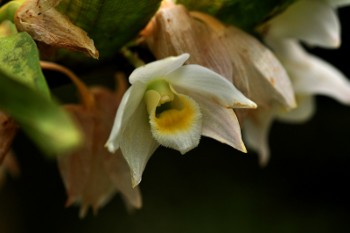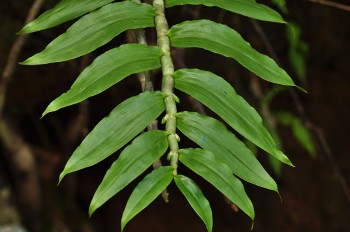Species of the Month – October 2014
Dendrobium aqueum Lindl.
Synonyms: Callista aquea (Lindl.) Kuntze, Dendrobium album Wight
Etymology: The name Dendrobium is derived from Greek words “Dendron” meaning Tree and “Bios” meaning Life. It alludes to the epiphytic habitat. “Aqueum” is derived from the latin word aqueus, meaning watery like, alludes to the appearance of flower.
Dendrobium aqueum Lindl. an epiphytic orchid commonly seen in many parts of Southern and Central Western Ghats in India. This species usually flowers in the months of September and October.

Flowers are 3.5 cm to 4.5 cm in size; fragrant; grows in fascicles of 2-3 and are greenish-white in color with a pale yellow-colored 3 lobed lip.
These are pretty big plants and can be easily sighted on tree branches covered with moss. Pseudobulbs or the canes are very prominent and are of the size 15cm to 45 cm with bigger leaves of 7.5 cm to 15 cm in size. They are also known as Devil’s Fingers because of their thicker canes.
These herbs are found in warm to cool growing temperatures and at elevations of 900 to 2200 meters of moist deciduous to evergreen forests. They love considerable amount of shade along with the moss grown on trees.

There are several threats posed for these species including road widening and logging in the Western Ghats region. Since these orchids can be seen all along the roads in the South Western Ghats, they are always at the risk of cut down because of road widening.
References:
1. Indian Orchids: Guide to Identification and Culture by Udai C. Pradhan
2.Wild Orchids of Northern Western Ghats by Satish Pande, Niranjan Sant, Vivek Vishwasrao, Mandar Datar.
Article by: Srikanth Parthasarthy